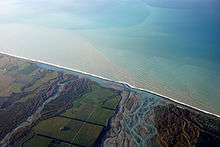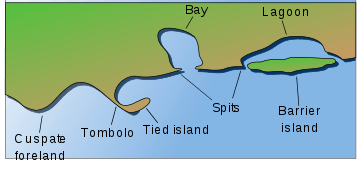Hapua
Hapua is the Māori term for river-mouth lagoons on mixed sand and gravel (MSG) beaches which form at the river-coast interface where a typically braided, although sometimes meandering, river interacts with a coastal environment that is significantly affected by longshore drift.[1] The lagoons which form on the MSG coastlines are common on the east coast of the South Island of New Zealand and have long been referred to as hapua by the Māori. This classification differentiates hapua from similar lagoons located on the New Zealand coast termed waituna. Hapua are often located on paraglacial coastal areas[2] where there is a low level of coastal development and minimal population density. Hapua form as the river carves out an elongated coast-parallel area, blocked from the sea by a MSG barrier which constantly alters its shape and volume due to longshore drift.[1][3] Longshore drift continually extends the barrier behind which the hapua forms by transporting sediment along the coast. Hapua are defined as a narrow shore-parallel extensions of the coastal riverbed.[3] They discharge the majority of stored water to the ocean via an ephemeral and highly mobile drainage channel or outlet.[4] The remainder percolates through the MSG barrier due to its high levels of permeability. Hapua systems are driven by a wide range of dynamic processes that are generally classified as fluvial or marine; changes in the balance between these processes as well as the antecedent barrier conditions can cause shifts in the morphology of the hapua, in particular the barrier. New Zealand examples include the Rakaia, Ashburton and Hurunui river-mouths.

References
- Kirk, R.M. and Lauder, G.A (2000). Significant coastal lagoon systems in the South Island, New Zealand: coastal processes and lagoon mouth closure. Department of Conservation.
- Zenkovich, V.P. (1967). "Processes of coastal development". Interscience Publishers. Cite journal requires
|journal=(help) - Hart, D. E. (2009). "River mouth lagoon science and management". Beach management, Principles and Practice. Earthscan Publications Ltd: 267, 280.
- “Paterson, A., Hume, T., & Healy, T. (2001). River mouth morphodynamics on a mixed sand-gravel coast. Journal of Coastal Research, 288–294.”
- “McLean, R. F. (1970). Variations in grain-size and sorting on two kaikoura beaches. New Zealand Journal of Marine and Freshwater Research, 4(2), 141–164.”
- “Davies, J. L. (1964). A morphogenic approach to world shorelines. Zeitschrift für Geomorphologie, 8, 127–142.”
- “Kirk, R. M. (1980). Mixed Sand and Gravel Beaches Morphology, Processes and Sediments. Progress in Physical Geography, 4(2), 189–210. doi:10.1177/030913338000400203”
- Single, M. (2011). "Lake Coleridge Project-Coastal processes at Rakaia River mouth". Cite journal requires
|journal=(help) - Kirk, R.M. (1991). "River-beach interaction on mixed sand and gravel coasts: a geomorphic model for water resource planning". Applied Geography: 267–287.
- ”Short, A.D. (1991). Macro-Meso Tidal Beach Morphodynamics: An Overview. Journal of Coastal Research,417-436.”
- Goring, D.G and Valentine, R.M. (1995). "Tidal Hydraulics of a large, gravel-bed river mouth: the Rakaia hapua". Cite journal requires
|journal=(help) - “Hume, T. M., & Herdendorf, C. E. (1988). A geomorphic classification of estuaries and its application to coastal resource management–A New-Zealand example. Ocean and Shoreline Management, 11(3), 249–274.”
- Hart, D.E. and Bryan, K.R (2008). "New Zealand coastal system boundaries, connections and management". New Zealand Geographer: 129–143.
- Single, M.B. and Hemmingson, M.A. (2001). "Mixed sand and gravel barrier beaches of South Canterbury, New Zealand". Ecology and Geomorphology of Coastal Shinge: 261–276.
- "McHaffie, N. (n.d.). A GIS based analysis of changes in the Rakaia Hapua, Canterbury."
- "Hart, D. E. (2009). Morphodynamics of non-estuarine rivermouth lagoons on high-energy coasts. Journal of Coastal Research, SI 56 Proceedings of the 10th International Coastal Symposium."

